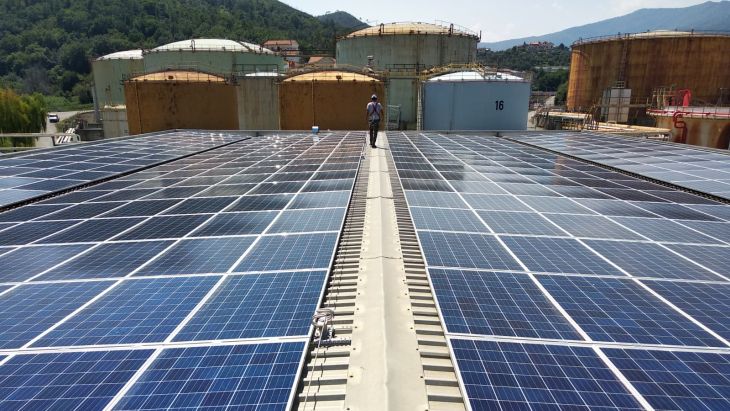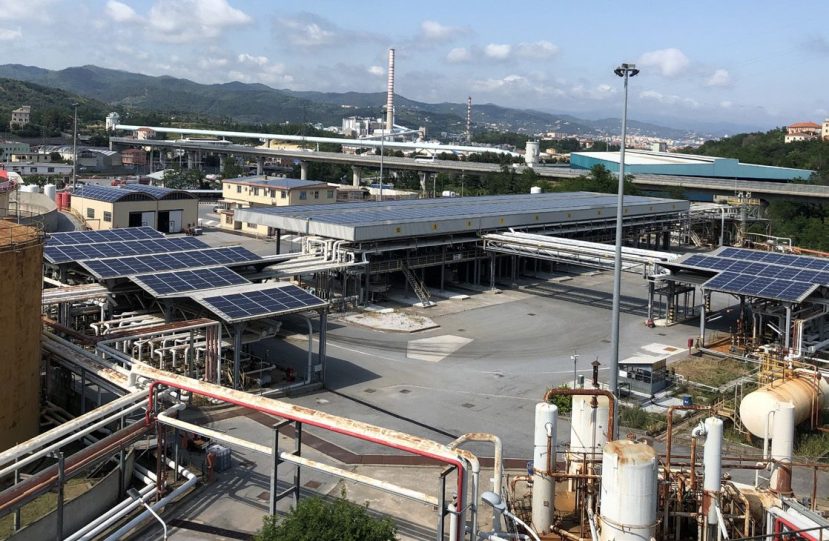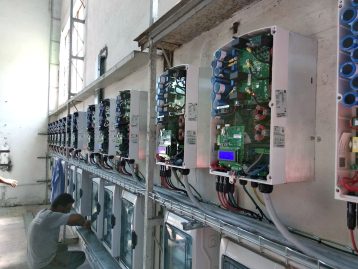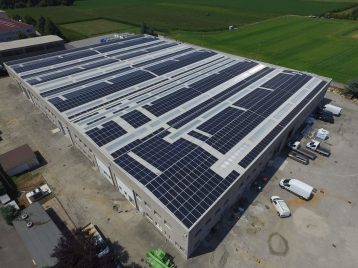
With millions of PV installations worldwide, solar energy is designed to be safe and reliable. However, when the sun is shining, the PV array and associated wiring can carry a high voltage, leaving the possibility of electrical arcing, which may cause fires. For this reason, safety should be a major consideration for organizations installing a solar energy system.
So, when All Energy & Architecture was approached to install a PV system at the highly combustible Alkion Terminal in Vado Ligure, it had no hesitation in recommending a 440kW system with 16 SolarEdge (SE27.6K) three phase inverters and 785 SolarEdge (P600) power optimizers. Alkion Terminal places a high priority on safety, which is why they chose SolarEdge’s smart energy solutions featuring advanced safety features designed to mitigate safety risks.
SolarEdge provided Alkion Terminal with superior safety from two embedded features, SafeDC™ and arc fault detection.
- SafeDC™ is designed to protect installers, maintenance personnel, and emergency responders from electrocution by reducing DC voltage to a touch safe 1V per module when AC power is off [1]
- Arc fault detection and interruption to mitigate fire risk [2]
“Because of the high fire risk at the fuel deposit, we chose a technology that would allow the customer to go about their business with total peace of mind”, explained Riccardo Betti, CEO of All Energy & Architecture. “We proposed SolarEdge DC optimized inverters due to its positive safety record, embedded SafeDC™, and arc fault detection technology. This PV solution allows the customer to work safely during normal operations and even during potential emergencies.”
The one thing you can’t compromise on is safety
As the PV industry grows and matures, stricter safety standards and regulations are becoming more commonplace, much the same as they are across many other industries. So, in addition to SafeDC™ and arc fault detection and interruption, SolarEdge has yet another product that is designed to protect first responders. Called the SolarEdge Firefighter Gateway, it provides manual and automatic system DC shutdown and a real-time indication of system DC voltage for safety assurance.
| SolarEdge System | Traditional inverters |
|---|---|
| SafeDC™ is always on and embedded in the technology. | Even when the inverter is shutdown, there could still be high voltage in the wiring, making it unsafe to the touch. |
| When AC power is off, the default output voltage of each power optimizer is a touch safe 1V per module. | Rooftop array disconnect switches only terminate the flow of current from the roof to the inverter. The modules on the roof, their cabling, and the cabling all the way to the inverter remain energized and dangerous while there is daylight. |
| SolarEdge inverters are designed to identify arc detections and subsequently shut down, in compliance with the UL1699B arc detection standard. | Third-party arc fault detectors are usually required. These hardware additions can add cost and may not be totally compliant with stringent safety standards. |
A positive return on investment
But it was not all about safety. From the outset, All Energy & Architecture recognized the possibility of delivering energy savings of up to 79,500 euros/year and yearly energy yields of up to 560,000 kWh. Furthermore, because other inverters generally have expensive add-on options to provide safety features like arc fault circuit interruption and rapid shutdown functionality, SolarEdge’s advanced SafeDC™ feature, already embedded in the inverter, allowed Alkion Terminal to avoid future and costly investments.
Contact your local SolarEdge office today for more information on this and other SolarEdge smart energy solutions, or visit the website.
[1] Certified in Europe as a DC disconnect According to IEC/EN 60947-1 and IEC/EN 60947-3, VDE AR 2100-712, and OVE R-11-1
[2] Compliant with the UL1699B arc detection standard



